 |
 |
Our enthusiastic and extremely knowledgeable perennials team is here to answer your questions and help you choose the best perennials for your situation. There’s always something in bloom for sun, shade, butterflies, birds or deer resistance as well as a variety of bulbs for your space.
Stroll through our time-tested favorites and introduce yourself to the newest varieties. We garden with perennials too; we love them and it shows!
|
57 found, showing page 1 of 4
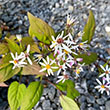
Height: 30 inches
Spread: 30 inches
Sunlight: partial shade full shade
Hardiness Zone: 3a
Other Names: syn. Aster divaricatus, White Star Aster
Description:
A profusion of airy white flowers with gold to red eyes, over a mound of small green leaves; thrives in shade and tolerates dry conditions; water the root zone instead of from the top to reduce fungal disease; water regularly to encourage more blooms
Ornamental Features:
White Wood Aster has masses of beautiful white flat-top daisy flowers with gold eyes at the ends of the stems from mid to late summer, which are most effective when planted in groupings. Its small heart-shaped leaves remain light green in color throughout the season.
Landscape Attributes:
White Wood Aster is an herbaceous perennial with an upright spreading habit of growth. It brings an extremely fine and delicate texture to the garden composition and should be used to full effect.
This is a relatively low maintenance plant, and is best cleaned up in early spring before it resumes active growth for the season. It is a good choice for attracting butterflies to your yard, but is not particularly attractive to deer who tend to leave it alone in favor of tastier treats. Gardeners should be aware of the following characteristic(s) that may warrant special consideration: Disease
White Wood Aster is recommended for the following landscape applications:
- Mass Planting
- Rock/Alpine Gardens
- Border Edging
- General Garden Use
- Groundcover
- Naturalizing And Woodland Gardens
- Container Planting
Planting & Growing:
White Wood Aster will grow to be about 30 inches tall at maturity, with a spread of 30 inches. Its foliage tends to remain dense right to the ground, not requiring facer plants in front. It grows at a medium rate, and under ideal conditions can be expected to live for approximately 4 years. As an herbaceous perennial, this plant will usually die back to the crown each winter, and will regrow from the base each spring. Be careful not to disturb the crown in late winter when it may not be readily seen!
This plant does best in partial shade to shade. It prefers to grow in average to dry locations, and dislikes excessive moisture. It is considered to be drought-tolerant, and thus makes an ideal choice for a low-water garden or xeriscape application. This plant should not require much in the way of fertilizing once established, although it may appreciate a shot of general-purpose fertilizer from time to time early in the growing season. It is not particular as to soil type or pH. It is somewhat tolerant of urban pollution. This species is native to parts of North America. It can be propagated by division.
White Wood Aster is a fine choice for the garden, but it is also a good selection for planting in outdoor pots and containers. With its upright habit of growth, it is best suited for use as a 'thriller' in the 'spiller-thriller-filler' container combination; plant it near the center of the pot, surrounded by smaller plants and those that spill over the edges. It is even sizeable enough that it can be grown alone in a suitable container. Note that when growing plants in outdoor containers and baskets, they may require more frequent waterings than they would in the yard or garden.

Purple-red blooms. Upright dark green-purple foliage. USDA 4-8
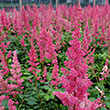
Magenta blooms. tolerates deer, heavy shade, & black walnut. USDA 3-8
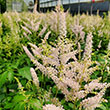
Delicate pinky peach flower spikes crown lacy green leaves. Tolerates deer, heavy shade, and black walnut. USDA 4-8

Pink blooms. Tolerates deer, heavy shade, & black walnut. USDA 4-8
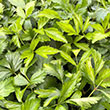
Clean white flowers on wide, feathery plumes. Blooms in early to midsummer. Bright green leaves. USDA 4-9
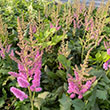
Pink blooms. Dwarf. Tolerates heavy shade, Wet sites & deer. USDA 4-8
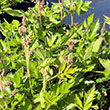
Pink blooms. Tolerates heavy shade, deer, & black walnut. USDA 4-8
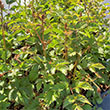
Purple to red blooms and dark green upright foliage. Perfers moist soil. USDA 4-8
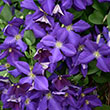
Height: 10 feet
Spread: 24 inches
Sunlight: full sun
Hardiness Zone: 3a
Other Names: Jackman's Clematis
Description:
The granddaddy of clematis, more popular than any other variety and for good reason; this variety features endless waves of rich velvet-blue flowers throughout the season; tough, hardy and thrives with neglect
Ornamental Features:
Jackmanii Clematis features showy royal blue star-shaped flowers with white anthers at the ends of the branches from mid summer to early fall. It has green deciduous foliage. The compound leaves do not develop any appreciable fall color.
Landscape Attributes:
Jackmanii Clematis is a multi-stemmed deciduous woody vine with a twining and trailing habit of growth. Its average texture blends into the landscape, but can be balanced by one or two finer or coarser trees or shrubs for an effective composition.
This is a relatively low maintenance woody vine. It is a Type 3 clematis; each spring it should be pruned back to within a few inches of the ground, as it flowers on new wood of the season. It is a good choice for attracting hummingbirds to your yard. It has no significant negative characteristics.
Jackmanii Clematis is recommended for the following landscape applications:
- Accent
- Hedges/Screening
- General Garden Use
- Container Planting
Planting & Growing:
Jackmanii Clematis will grow to be about 10 feet tall at maturity, with a spread of 24 inches. As a climbing vine, it tends to be leggy near the base and should be underplanted with low-growing facer plants. It should be planted near a fence, trellis or other landscape structure where it can be trained to grow upwards on it, or allowed to trail off a retaining wall or slope. It grows at a medium rate, and under ideal conditions can be expected to live for approximately 20 years.
This woody vine should only be grown in full sunlight. It does best in average to evenly moist conditions, but will not tolerate standing water. It is not particular as to soil type or pH. It is highly tolerant of urban pollution and will even thrive in inner city environments. Consider applying a thick mulch around the root zone in both summer and winter to conserve soil moisture and protect it in exposed locations or colder microclimates. This particular variety is an interspecific hybrid.
Jackmanii Clematis makes a fine choice for the outdoor landscape, but it is also well-suited for use in outdoor pots and containers. Because of its spreading habit of growth, it is ideally suited for use as a 'spiller' in the 'spiller-thriller-filler' container combination; plant it near the edges where it can spill gracefully over the pot. It is even sizeable enough that it can be grown alone in a suitable container. Note that when grown in a container, it may not perform exactly as indicated on the tag - this is to be expected. Also note that when growing plants in outdoor containers and baskets, they may require more frequent waterings than they would in the yard or garden.

Massive clusters of vibrant, magenta flowers bloom profusely in summer. Vigorous grower. USDA 4-11
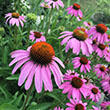
Plant Height: 24 inches
Flower Height: 3 feet
Spread: 24 inches
Sunlight: full sun
Hardiness Zone: 3a
Other Names: Purple Coneflower
Description:
Tall sturdy stems rising above green foliage produce beautifully fragrant rosy-pink daisy-like flowers with copper-orange center cones; easy to grow and drought tolerant, excellent for borders, rock gardens or added to fresh or dried arrangements
Ornamental Features:
Bravado Coneflower has masses of beautiful lightly-scented rose daisy flowers with coppery-bronze eyes at the ends of the stems from mid summer to mid fall, which are most effective when planted in groupings. The flowers are excellent for cutting. Its pointy leaves remain green in color throughout the season.
Landscape Attributes:
Bravado Coneflower is an herbaceous perennial with an upright spreading habit of growth. Its medium texture blends into the garden, but can always be balanced by a couple of finer or coarser plants for an effective composition.
This is a relatively low maintenance plant, and is best cleaned up in early spring before it resumes active growth for the season. It is a good choice for attracting birds and butterflies to your yard, but is not particularly attractive to deer who tend to leave it alone in favor of tastier treats. It has no significant negative characteristics.
Bravado Coneflower is recommended for the following landscape applications:
- Mass Planting
- Rock/Alpine Gardens
- Border Edging
- General Garden Use
- Container Planting
Planting & Growing:
Bravado Coneflower will grow to be about 24 inches tall at maturity extending to 3 feet tall with the flowers, with a spread of 24 inches. It grows at a medium rate, and under ideal conditions can be expected to live for approximately 10 years. As an herbaceous perennial, this plant will usually die back to the crown each winter, and will regrow from the base each spring. Be careful not to disturb the crown in late winter when it may not be readily seen!
This plant should only be grown in full sunlight. It is very adaptable to both dry and moist locations, and should do just fine under typical garden conditions. It is considered to be drought-tolerant, and thus makes an ideal choice for a low-water garden or xeriscape application. It is not particular as to soil type or pH. It is highly tolerant of urban pollution and will even thrive in inner city environments. This is a selection of a native North American species. It can be propagated by division; however, as a cultivated variety, be aware that it may be subject to certain restrictions or prohibitions on propagation.
Bravado Coneflower is a fine choice for the garden, but it is also a good selection for planting in outdoor pots and containers. With its upright habit of growth, it is best suited for use as a 'thriller' in the 'spiller-thriller-filler' container combination; plant it near the center of the pot, surrounded by smaller plants and those that spill over the edges. It is even sizeable enough that it can be grown alone in a suitable container. Note that when growing plants in outdoor containers and baskets, they may require more frequent waterings than they would in the yard or garden.
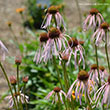
Thin, pale lavender petals. Heat and drought tolerant. Native. USDA 3-10
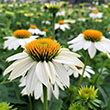
Plant Height: 18 inches
Flower Height: 24 inches
Spread: 18 inches
Sunlight: full sun
Hardiness Zone: 3a
Other Names: Pow Wow White Coneflower
Brand: Proven Winners
Description:
This attractive echinacea produces large pure white flowers with coppery centers; a perfect choice for planting in groups, along border edges, or in containers; great for flower arrangements, attracts pollinators
Ornamental Features:
PowWow White Coneflower has masses of beautiful lightly-scented white daisy flowers with coppery-bronze eyes at the ends of the stems from mid summer to early fall, which are most effective when planted in groupings. The flowers are excellent for cutting. Its pointy leaves remain green in color throughout the season.
Landscape Attributes:
PowWow White Coneflower is an herbaceous perennial with an upright spreading habit of growth. Its medium texture blends into the garden, but can always be balanced by a couple of finer or coarser plants for an effective composition.
This is a relatively low maintenance plant, and is best cleaned up in early spring before it resumes active growth for the season. It is a good choice for attracting birds and butterflies to your yard, but is not particularly attractive to deer who tend to leave it alone in favor of tastier treats. It has no significant negative characteristics.
PowWow White Coneflower is recommended for the following landscape applications:
- Mass Planting
- General Garden Use
- Container Planting
Planting & Growing:
PowWow White Coneflower will grow to be about 18 inches tall at maturity extending to 24 inches tall with the flowers, with a spread of 18 inches. It grows at a medium rate, and under ideal conditions can be expected to live for approximately 10 years. As an herbaceous perennial, this plant will usually die back to the crown each winter, and will regrow from the base each spring. Be careful not to disturb the crown in late winter when it may not be readily seen!
This plant should only be grown in full sunlight. It is very adaptable to both dry and moist locations, and should do just fine under typical garden conditions. It is considered to be drought-tolerant, and thus makes an ideal choice for a low-water garden or xeriscape application. It is not particular as to soil type or pH. It is highly tolerant of urban pollution and will even thrive in inner city environments. This is a selection of a native North American species. It can be propagated by division; however, as a cultivated variety, be aware that it may be subject to certain restrictions or prohibitions on propagation.
PowWow White Coneflower is a fine choice for the garden, but it is also a good selection for planting in outdoor pots and containers. With its upright habit of growth, it is best suited for use as a 'thriller' in the 'spiller-thriller-filler' container combination; plant it near the center of the pot, surrounded by smaller plants and those that spill over the edges. Note that when growing plants in outdoor containers and baskets, they may require more frequent waterings than they would in the yard or garden.
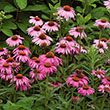
Fully double coral & raspberry blooms. Dark stems & foliage. USDA 4-9
57 found, showing page 1 of 4















